Heim >Java >javaLernprogramm >So implementieren Sie das Springboot-Funktionsmodul für den Bildverifizierungscode
So implementieren Sie das Springboot-Funktionsmodul für den Bildverifizierungscode
- 王林nach vorne
- 2023-05-17 15:16:061471Durchsuche
Der spezifische Effekt ist wie folgt:
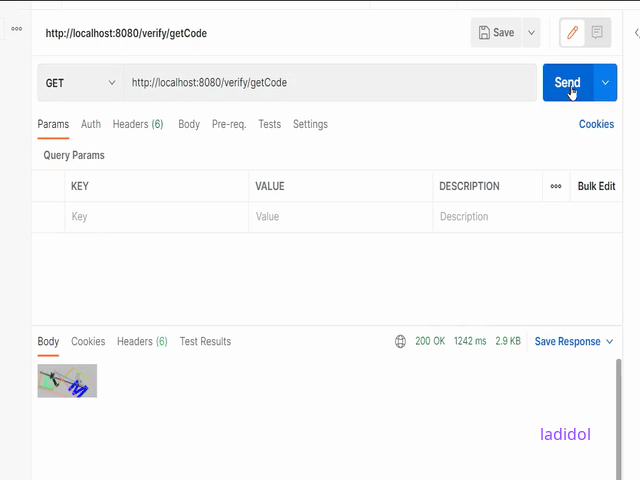
Schritt 1: Tool-Klasse
Diese Tool-Klasse ist der Kern der Generierung von Verifizierungscode-Bildern. Sie können sie ohne Änderung direkt in das Projekt kopieren kann personalisiert werden. Für extern bereitgestellte APIs wie können Sie entsprechende Parameter entsprechend Ihren eigenen Anforderungen festlegen. 字体大小,背景颜色,干扰线数量,高宽
package com.feng.util;
/**
* @return null
* @author Ladidol
* @description
* @date 2022/4/11 22:15
*/
import java.awt.*;
import java.awt.geom.AffineTransform;
import java.awt.image.BufferedImage;
import java.util.Random;
/**
* 图形验证码生成
*/
public class VerifyUtil {
// 默认验证码字符集
private static final char[] chars = {
'0', '1', '2', '3', '4', '5', '6', '7', '8', '9',
'a', 'b', 'c', 'd', 'e', 'f', 'g', 'h', 'i', 'j', 'k', 'l', 'm', 'n', 'o', 'p', 'q', 'r', 's', 't', 'u', 'v', 'w', 'x', 'y', 'z',
'A', 'B', 'C', 'D', 'E', 'F', 'G', 'H', 'I', 'J', 'K', 'L', 'M', 'N', 'O', 'P', 'Q', 'R', 'S', 'T', 'U', 'V', 'W', 'X', 'Y', 'Z'};
// 默认字符数量
private final Integer SIZE;
// 默认干扰线数量
private final int LINES;
// 默认宽度
private final int WIDTH;
// 默认高度
private final int HEIGHT;
// 默认字体大小
private final int FONT_SIZE;
// 默认字体倾斜
private final boolean TILT;
private final Color BACKGROUND_COLOR;
/**
* 初始化基础参数
*
* @param builder
*/
private VerifyUtil(Builder builder) {
SIZE = builder.size;
LINES = builder.lines;
WIDTH = builder.width;
HEIGHT = builder.height;
FONT_SIZE = builder.fontSize;
TILT = builder.tilt;
BACKGROUND_COLOR = builder.backgroundColor;
}
/**
* 实例化构造器对象
*
* @return
*/
public static Builder newBuilder() {
return new Builder();
}
/**
* @return 生成随机验证码及图片
* Object[0]:验证码字符串;
* Object[1]:验证码图片。
*/
public Object[] createImage() {
StringBuffer sb = new StringBuffer();
// 创建空白图片
BufferedImage image = new BufferedImage(WIDTH, HEIGHT, BufferedImage.TYPE_INT_RGB);
// 获取图片画笔
Graphics2D graphic = image.createGraphics();
// 设置抗锯齿
graphic.setRenderingHint(RenderingHints.KEY_ANTIALIASING, RenderingHints.VALUE_ANTIALIAS_ON);
// 设置画笔颜色
graphic.setColor(BACKGROUND_COLOR);
// 绘制矩形背景
graphic.fillRect(0, 0, WIDTH, HEIGHT);
// 画随机字符
Random ran = new Random();
//graphic.setBackground(Color.WHITE);
// 计算每个字符占的宽度,这里预留一个字符的位置用于左右边距
int codeWidth = WIDTH / (SIZE + 1);
// 字符所处的y轴的坐标
int y = HEIGHT * 3 / 4;
for (int i = 0; i < SIZE; i++) {
// 设置随机颜色
graphic.setColor(getRandomColor());
// 初始化字体
Font font = new Font(null, Font.BOLD + Font.ITALIC, FONT_SIZE);
if (TILT) {
// 随机一个倾斜的角度 -45到45度之间
int theta = ran.nextInt(45);
// 随机一个倾斜方向 左或者右
theta = (ran.nextBoolean() == true) ? theta : -theta;
AffineTransform affineTransform = new AffineTransform();
affineTransform.rotate(Math.toRadians(theta), 0, 0);
font = font.deriveFont(affineTransform);
}
// 设置字体大小
graphic.setFont(font);
// 计算当前字符绘制的X轴坐标
int x = (i * codeWidth) + (codeWidth / 2);
// 取随机字符索引
int n = ran.nextInt(chars.length);
// 得到字符文本
String code = String.valueOf(chars[n]);
// 画字符
graphic.drawString(code, x, y);
// 记录字符
sb.append(code);
}
// 画干扰线
for (int i = 0; i < LINES; i++) {
// 设置随机颜色
graphic.setColor(getRandomColor());
// 随机画线
graphic.drawLine(ran.nextInt(WIDTH), ran.nextInt(HEIGHT), ran.nextInt(WIDTH), ran.nextInt(HEIGHT));
}
// 返回验证码和图片
return new Object[]{sb.toString(), image};
}
/**
* 随机取色
*/
private Color getRandomColor() {
Random ran = new Random();
Color color = new Color(ran.nextInt(256), ran.nextInt(256), ran.nextInt(256));
return color;
}
/**
* 构造器对象
*/
public static class Builder {
// 默认字符数量
private int size = 4;
// 默认干扰线数量
private int lines = 10;
// 默认宽度
private int width = 80;
// 默认高度
private int height = 35;
// 默认字体大小
private int fontSize = 25;
// 默认字体倾斜
private boolean tilt = true;
//背景颜色
private Color backgroundColor = Color.LIGHT_GRAY;
public Builder setSize(int size) {
this.size = size;
return this;
}
public Builder setLines(int lines) {
this.lines = lines;
return this;
}
public Builder setWidth(int width) {
this.width = width;
return this;
}
public Builder setHeight(int height) {
this.height = height;
return this;
}
public Builder setFontSize(int fontSize) {
this.fontSize = fontSize;
return this;
}
public Builder setTilt(boolean tilt) {
this.tilt = tilt;
return this;
}
public Builder setBackgroundColor(Color backgroundColor) {
this.backgroundColor = backgroundColor;
return this;
}
public VerifyUtil build() {
return new VerifyUtil(this);
}
}
}Schritt 2: Bildgenerierung:Standardparameter verwenden://生成图片验证码 Object[] verify = VerifyUtil.newBuilder().build().createImage();Benutzerdefinierte Parametergenerierung:
// 这个根据自己的需要设置对应的参数来实现个性化
// 返回的数组第一个参数是生成的验证码,第二个参数是生成的图片
Object[] objs = VerifyUtil.newBuilder()
.setWidth(120) //设置图片的宽度
.setHeight(35) //设置图片的高度
.setSize(6) //设置字符的个数
.setLines(10) //设置干扰线的条数
.setFontSize(25) //设置字体的大小
.setTilt(true) //设置是否需要倾斜
.setBackgroundColor(Color.WHITE) //设置验证码的背景颜色
.build() //构建VerifyUtil项目
.createImage(); //生成图片In das Springboot-Projekt integrieren:Maven-Abhängigkeiten, die eingeführt werden müssen: <!--redis相关配置-->
<dependency>
<groupId>org.springframework.boot</groupId>
<artifactId>spring-boot-starter-data-redis</artifactId>
</dependency>
<!-- redis 连接池 -->
<!--新版本连接池lettuce-->
<dependency>
<groupId>org.apache.commons</groupId>
<artifactId>commons-pool2</artifactId>
</dependency>
<!-- 图形验证码 -->
<dependency>
<groupId>net.jodah</groupId>
<artifactId>expiringmap</artifactId>
<version>0.5.10</version>
</dependency>Den relevanten Bestätigungscode abrufen:
Service-Schicht:
package com.feng.service;
import org.cuit.epoch.result.Result;
import javax.servlet.http.HttpServletRequest;
import javax.servlet.http.HttpServletResponse;
import java.io.IOException;
/**
* @return null
* @author Ladidol
* @description
* @date 2022/4/11 22:15
*/
public interface VerifyService {
/**
* 创建图片验证码
* @param response
* @param request
* @throws IOException
*/
void createCode(HttpServletResponse response, HttpServletRequest request) throws IOException;
/**
* 检查图片验证码
* @param
* @param
* @throws IOException
*/
Result<String> checkCode(String verificationCode);
}
Serviceimpl-Schicht:
package com.feng.service.impl;
import com.feng.service.VerifyService;
import com.feng.util.RedisServiceImpl;
import com.google.common.net.HttpHeaders;
import com.feng.util.VerifyUtil;
import org.springframework.http.ResponseCookie;
import org.springframework.stereotype.Service;
import javax.annotation.Resource;
import javax.imageio.ImageIO;
import javax.servlet.http.HttpServletRequest;
import javax.servlet.http.HttpServletResponse;
import javax.servlet.http.HttpSession;
import java.awt.image.BufferedImage;
import java.io.IOException;
import java.io.OutputStream;
import java.time.Duration;
/**
* @return null
* @author Ladidol
* @description
* @date 2022/4/11 22:15
*/
@Service
public class VerifyServiceImpl implements VerifyService {
@Resource
RedisServiceImpl redisUtil;
/**
* 生成图片验证码
* @param response
* @param request
* @throws IOException
*/
@Override
public void createCode(HttpServletResponse response, HttpServletRequest request) throws IOException {
//获取session
HttpSession session = request.getSession();
//获得sessionId
String id = session.getId();
System.out.println();
ResponseCookie cookie = ResponseCookie.from("JSESSIONID",id)
.secure(true)
.domain("")
.path("/")
.maxAge(Duration.ofHours(1))
.sameSite("None")
.build();
//清除之前缓存的图片验证码
if (!String.valueOf(request.getSession().getAttribute("SESSION_VERIFY_CODE_"+id)).isEmpty()){
String getVerify = String.valueOf(request.getSession().getAttribute("SESSION_VERIFY_CODE_"+id));
redisUtil.del(getVerify);
System.out.println("清除成功");
}
//生成图片验证码,用的默认参数
Object[] verify = VerifyUtil.newBuilder().build().createImage();
//将验证码存入session
session.setAttribute("SESSION_VERIFY_CODE_" + id, verify[0]);
//打印验证码
System.out.println(verify[0]);
//将验证码存入redis
redisUtil.set((String) verify[0],id,5*60);
//将图片传给浏览器
BufferedImage image = (BufferedImage) verify[1];
response.setContentType("image/png");
response.setHeader(HttpHeaders.SET_COOKIE,cookie.toString());
OutputStream ops = response.getOutputStream();
ImageIO.write(image,"png",ops);
}
@Override
public Result<String> checkCode(String verificationCode){
if (!redisUtil.hasKey(verificationCode)){
return new Result<>(false,"验证码错误");
}
redisUtil.del(verificationCode);
return R.success();
}
}Hier werden auch Redis-bezogene Tool-Klassen verwendet. Wenn Sie möchten, können Sie sich hier meine vorherigen Blog-Tool-Klassen ansehen .
Controller-Schicht:@RequiredArgsConstructor wird hier verwendet, es ist nur eine einfache Injektion. Wenn Sie mehr darüber erfahren möchten, klicken Sie hier.
package com.feng.controller;
import lombok.RequiredArgsConstructor;
import com.feng.annotation.LimitRequest;
import com.feng.service.VerifyService;
import org.springframework.web.bind.annotation.*;
import javax.servlet.http.HttpServletRequest;
import javax.servlet.http.HttpServletResponse;
import java.io.IOException;
/**
* @return null
* @author Ladidol
* @description 这里主要就是多种验证码和登录相关的东西
* @date 2022/4/11 21:46
*/
@RestController
@RequestMapping("/verify")
@RequiredArgsConstructor//这是在lombok工具给的注入方式,真帅
public class VerifyController {
private final VerifyService verifyService;
/**
* 获取图片验证码
*/
@LimitRequest(count = 5)//这个注解就是表示, 你在限制时间里(我们这里默认是六秒钟), 只能请求五次
@GetMapping("/getCode")
public void getCode(HttpServletResponse response, HttpServletRequest request) throws IOException {
verifyService.createCode(response, request);
}
@LimitRequest(count = 5)//这个注解就是表示, 你在限制时间里(我们这里默认是六秒钟), 只能请求五次
@GetMapping("/checkCode")
public Result<String> checkCode(String code){
return verifyService.checkCode(code);
}
}Hier verwenden wir, um den uneingeschränkten Zugriff auf den Dienst zu verhindern a eingeschränkter IP-Zugriff Anzahl der Annotationen @LimitRequest
Annotationsklasse unter dem Annotationspaket:
package com.feng.annotation;
import java.lang.annotation.*;
/**
* @return null
* @author Ladidol
* @description 限制ip访问次数注解
* @date 2022/4/11 22:15
*/
@Documented
@Target(ElementType.METHOD) // 说明该注解只能放在方法上面
@Retention(RetentionPolicy.RUNTIME)
public @interface LimitRequest {
long time() default 6000; // 限制时间 单位:毫秒
int count() default 3; // 允许请求的次数
}
Aspektklasse unter dem Aspektpaket:
package com.feng.aspect;
import net.jodah.expiringmap.ExpirationPolicy;
import net.jodah.expiringmap.ExpiringMap;
import org.aspectj.lang.ProceedingJoinPoint;
import org.aspectj.lang.annotation.Around;
import org.aspectj.lang.annotation.Aspect;
import org.aspectj.lang.annotation.Pointcut;
import com.feng.annotation.LimitRequest;
import org.cuit.epoch.exception.AppException;
import org.springframework.stereotype.Component;
import org.springframework.web.context.request.RequestAttributes;
import org.springframework.web.context.request.RequestContextHolder;
import org.springframework.web.context.request.ServletRequestAttributes;
import javax.servlet.http.HttpServletRequest;
import java.util.concurrent.ConcurrentHashMap;
import java.util.concurrent.TimeUnit;
/**
* @return null
* @author Ladidol
* @description
* @date 2022/4/11 22:15
*/
@Aspect
@Component
public class LimitRequestAspect {
private static ConcurrentHashMap<String, ExpiringMap<String, Integer>> book = new ConcurrentHashMap<>();
// 定义切点
// 让所有有@LimitRequest注解的方法都执行切面方法
@Pointcut("@annotation(limitRequest)")
public void excudeService(LimitRequest limitRequest) {
}
@Around("excudeService(limitRequest)")
public Object doAround(ProceedingJoinPoint pjp, LimitRequest limitRequest) throws Throwable {
// 获得request对象
RequestAttributes ra = RequestContextHolder.getRequestAttributes();
ServletRequestAttributes sra = (ServletRequestAttributes) ra;
HttpServletRequest request = sra.getRequest();
// 获取Map对象, 如果没有则返回默认值
// 第一个参数是key, 第二个参数是默认值
ExpiringMap<String, Integer> uc = book.getOrDefault(request.getRequestURI(), ExpiringMap.builder().variableExpiration().build());
Integer uCount = uc.getOrDefault(request.getRemoteAddr(), 0);
if (uCount >= limitRequest.count()) { // 超过次数,不执行目标方法
System.out.println("接口请求超过次数!");
throw new AppException("接口请求超过次数!");
} else if (uCount == 0) { // 第一次请求时,设置有效时间
//
uc.put(request.getRemoteAddr(), uCount + 1, ExpirationPolicy.CREATED, limitRequest.time(), TimeUnit.MILLISECONDS);
} else { // 未超过次数, 记录加一
uc.put(request.getRemoteAddr(), uCount + 1);
}
book.put(request.getRequestURI(), uc);
// result的值就是被拦截方法的返回值
Object result = pjp.proceed();
return result;
}
}Um ausgelöste globale Ausnahmen zu erfassen und Restful-Spezifikationen einzuhalten, Wir fügen diese Verarbeitungsklasse hinzu: Die globale Ausnahmeklasse unter dem
Handle-Paket:
package org.cuit.epoch.handler;
import lombok.extern.log4j.Log4j2;
import org.cuit.epoch.exception.AppException;
import org.cuit.epoch.result.R;
import org.cuit.epoch.result.Result;
import org.springframework.web.bind.annotation.ControllerAdvice;
import org.springframework.web.bind.annotation.ExceptionHandler;
import org.springframework.web.bind.annotation.ResponseBody;
@ControllerAdvice
@Log4j2
public class GlobalExceptionHandler {
@ExceptionHandler(Exception.class)
@ResponseBody
public Result error(Exception e) {
log.error(e.getMessage());
e.printStackTrace();
return R.fail(e.getMessage());
}
@ExceptionHandler(AppException.class)
@ResponseBody
public Result error(AppException e) {
log.error(e.getMessage());
e.printStackTrace();
return R.fail(e.getMessage());
}
}
application.yaml-Datei:
spring:
cache:
type:
redis
redis: #redis连接配置
host: 自己redis的ip地址
port: redis端口
password: 密码
jedis:
pool:
max-active: 8
max-wait: -1ms
max-idle: 500
min-idle: 0
lettuce:
shutdown-timeout: 0ms
Die endgültige Projektstruktur ist wie folgt:
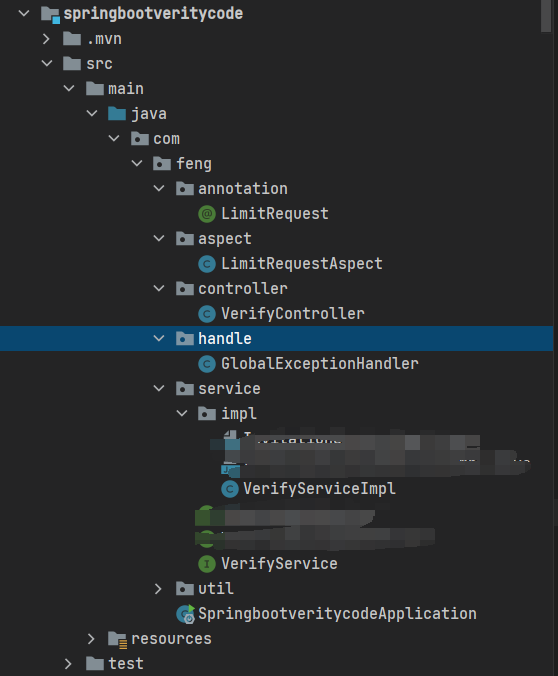
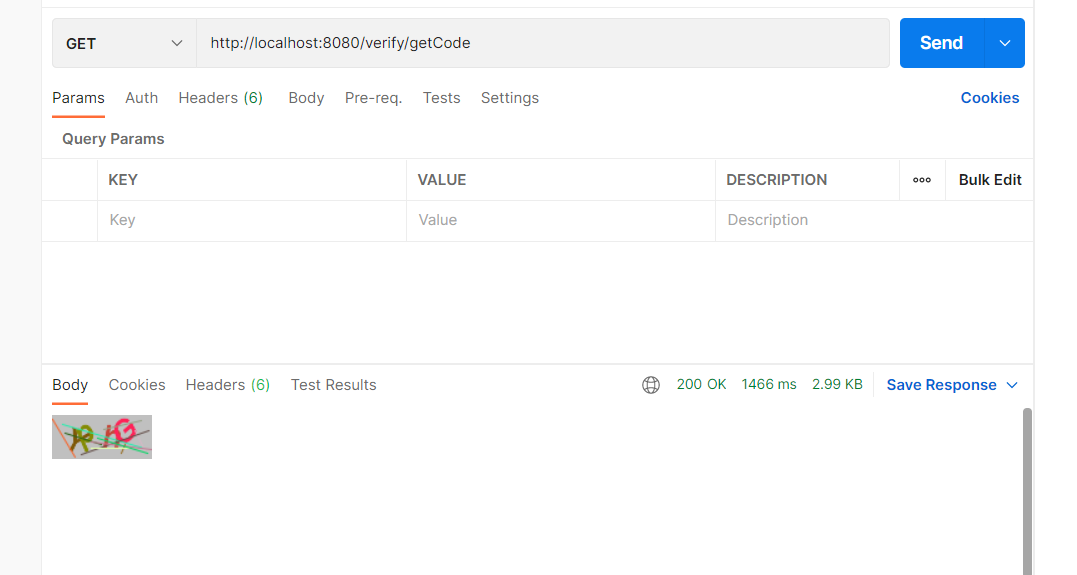
Erfolgsergebnis:
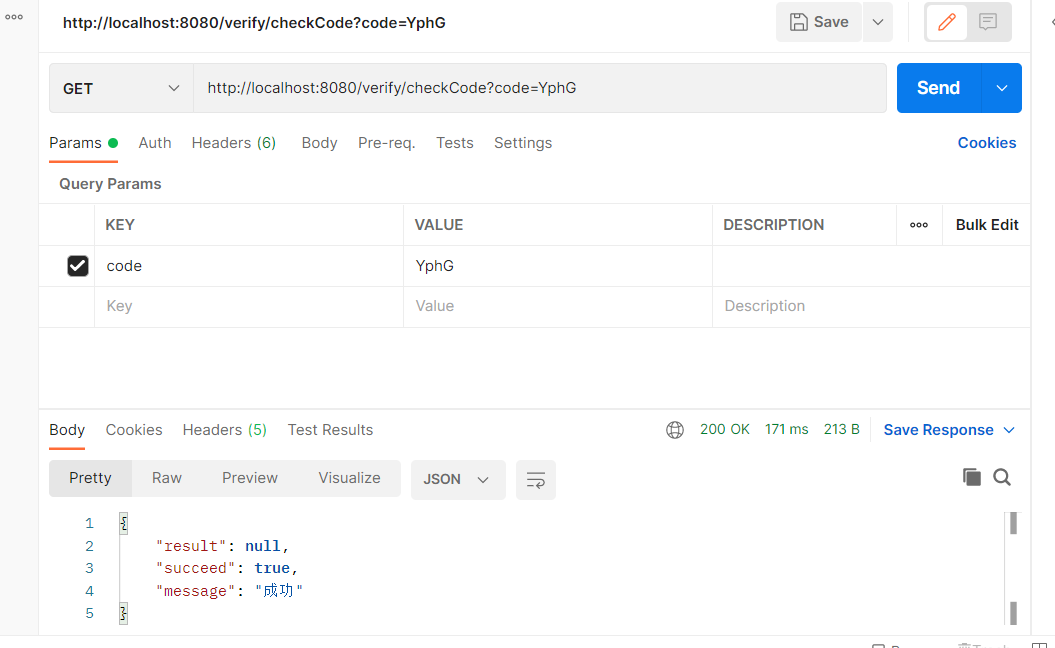
Verifizierungsfehlerergebnis:
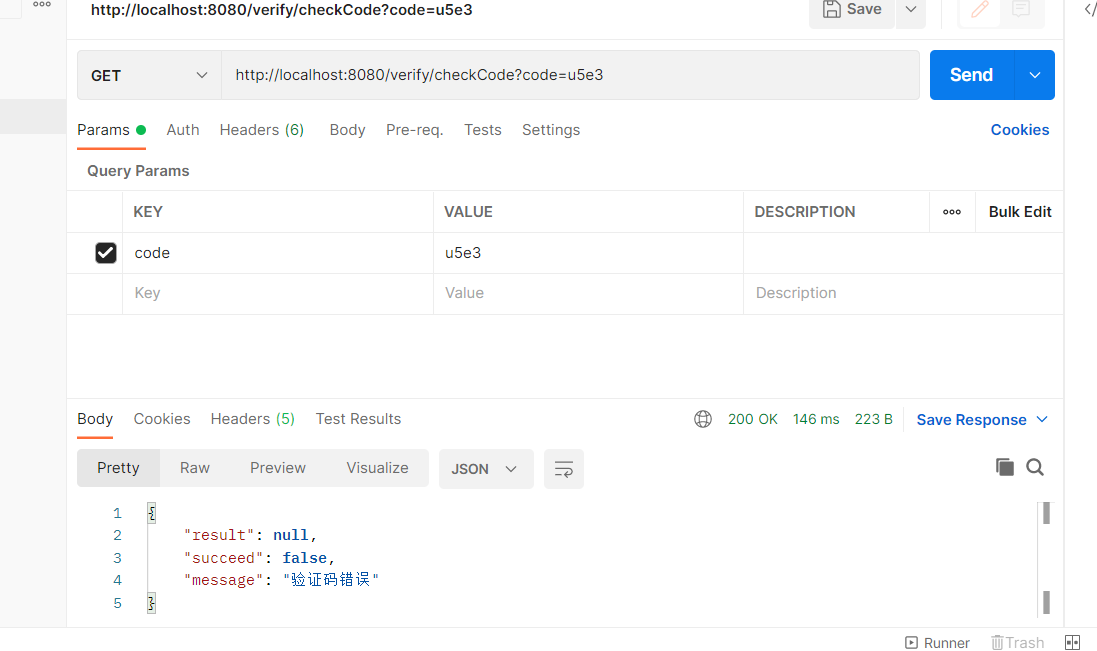

Das obige ist der detaillierte Inhalt vonSo implementieren Sie das Springboot-Funktionsmodul für den Bildverifizierungscode. Für weitere Informationen folgen Sie bitte anderen verwandten Artikeln auf der PHP chinesischen Website!

